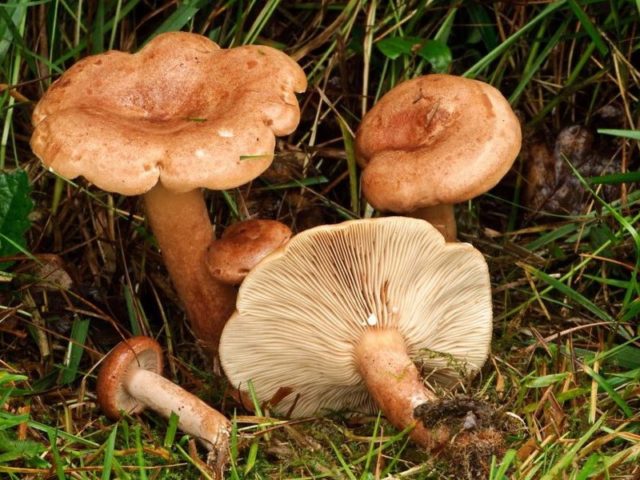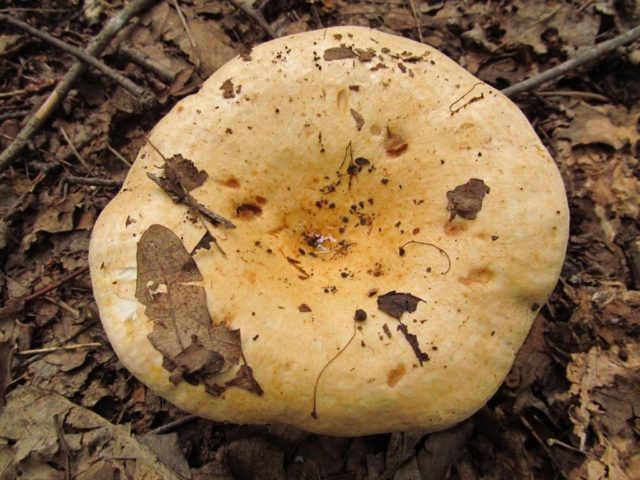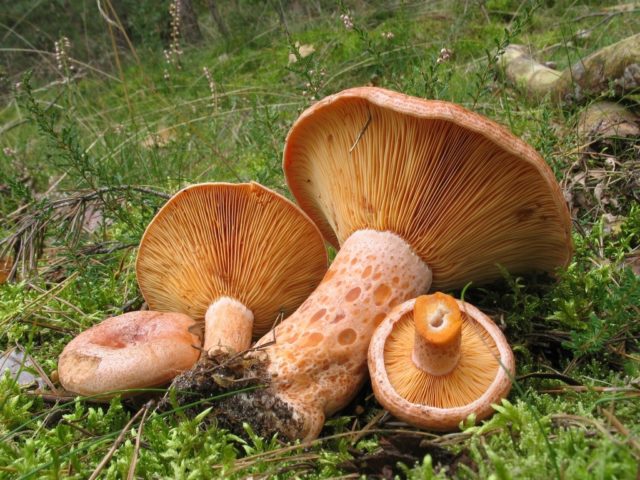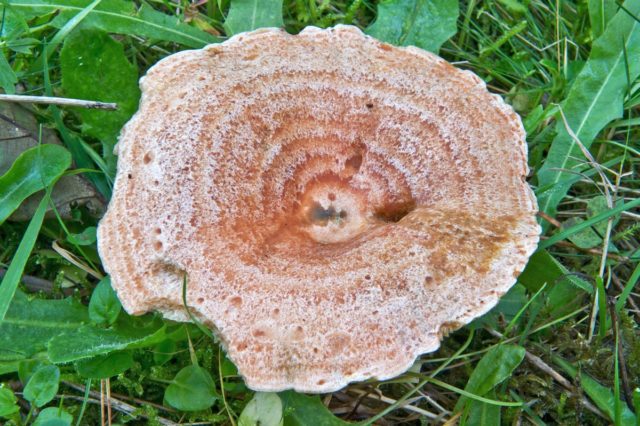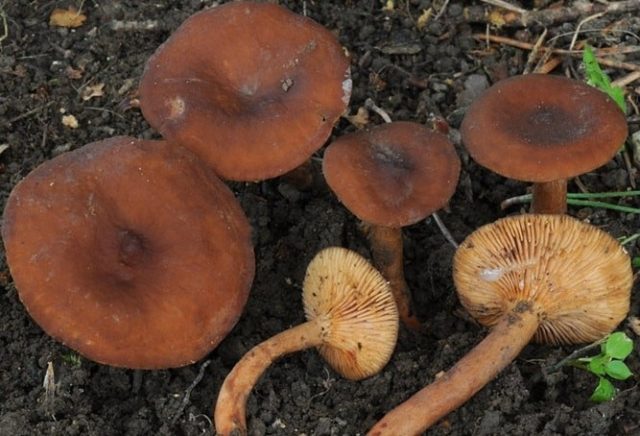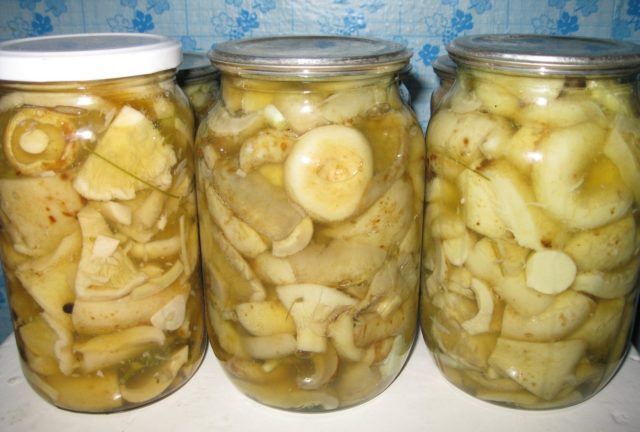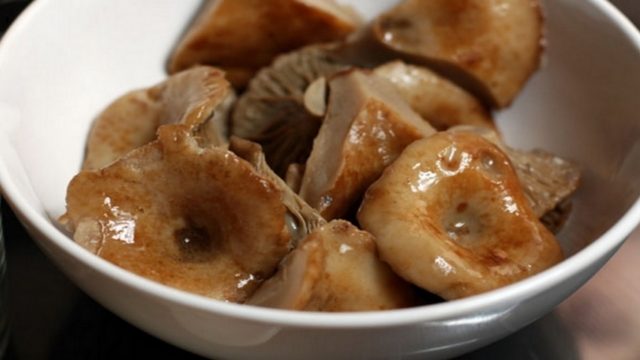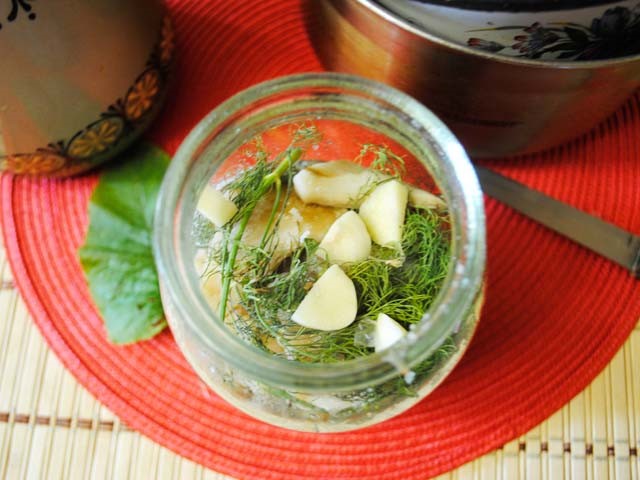Content
Oak lump is an edible lamellar mushroom, highly prized in a salted form. It is a member of the russula family, of the genus Millechniki, a characteristic feature of which is the release of juice at the fracture of the pulp. In scientific publications, it bears the name Lactarius zonarius or Lactarius insulsus. It is known as oak saffron milk cap, podrozhik, leaflet.
Description of oak mushroom
The bright color of the surfaces of the caps and legs of oak mushrooms, as their location, make it possible to quickly determine the species. It stands out significantly from other members of the family.
Description of the hat
Young mushrooms appear with a flat round cap, which over time grows to 10-11 cm and takes on a funnel-shaped shape with tucked, wavy edges. The texture of the border is slightly felt. The skin of an oak bean, as in the photo, is bright: reddish or orange, up to various terracotta shades. Separate, darker areas are sometimes visible.
From below, densely located wide plates converge to the leg. The color is also changeable - from whitish pink to yellowish or orange. The mass of spores is yellow-cream or buffy.
The dense flesh of oak camelina is white-creamy, gives off a pleasant smell on the cut, turns slightly pink. A little white watery juice appears slightly, acrid, like in most milkers, which does not change color in the air.
Leg description
The smooth leg of the oak mass is dense downwards, slightly narrowed, a cavity is visible when cut. The walls are whitish-pink. The height of the leg is up to 7 cm, diameter is up to 3 cm. The shade of the surface is lighter than that of the cap, small depressions are darker.
Where and how it grows
Oak mushrooms are found in the southern temperate zone, where warm weather and broad-leaved forests prevail. The species creates mycorrhiza:
- with oaks;
- hornbeams;
- beeches;
- hazel.
Oak mushrooms are common, sometimes solitary, but usually in families. Fruit bodies are formed underground. They are shown already large, with a leg up to 1.5 cm wide, 3 cm high and a cap up to 4-5 cm. The species is found in the Caucasus, in the Krasnodar Territory, Crimean forests and in other areas with broad-leaved plantations. Sometimes oak mushrooms are also found in pine forests. Fruiting from July to September, early October. Especially successful mushroom hunting for oak mushrooms occurs at the end of August and in September.
Doubles and their differences
Since the genus of milkmen is vast, the bruises are similar in shape to the rest of the representatives of various types of milk mushrooms, but not in color. It is necessary to remember the distinctive characteristics of oak mushrooms:
- conspicuous yellow-orange or terracotta cap;
- the leg is slightly lighter;
- the juice remains white-watery;
- the pulp turns slightly pink at the break;
- found in the southern regions of the temperate strip under broadleaf trees.
Mushrooms of the species are similar to other lactarius with warm-seasoned skins:
- common mushroom;
- spruce mushroom;
- redhead japanese;
- a blue lump;
- watery milky.
Mushroom pickers are not too afraid to confuse oak milk mushrooms with any similar mushrooms, since they all belong to the same genus, and among them there is no fruiting body with toxins. All representatives of the genus of the lactarius are conditionally edible.
Oak mushroom most often grows in deciduous forests, and mushrooms and other types of milkmen prefer coniferous and mixed forests, where spruce, pine, aspen, and birch alternate.
The difference between doubles and oak load:
- common mushrooms can be found mainly in pine and spruce forests;
- the flesh of a real mushroom becomes greenish at the break, orange juice appears, which also turns green in the air;
- in spruce saffron milk cap, even after pressure, the affected areas on the leg and on the plates turn green, and the juice is reddish;
- although the shape of the Japanese camelina is identical with the oak mushroom, the skin on the cap is light pink or reddish, it has clearly defined concentric zones of a darker color, and the juice is intensely red;
- Japanese camelina is found only in the south of Primorsky Krai in mixed and coniferous forests;
- the skin on the cap is yellowish with a bluish weight, the edges break off easily;
- when pressed, bluish spots appear on the surface of the leg of a bluish appearance, and whitish juice appears on the cuts, which, under the influence of air, becomes blue-violet;
- blue mushrooms grow most often under pines and birches, although they are also found under other trees;
- the cap is brownish-buffy, and the stem is darker than the top, brownish.
Are oak mushrooms edible or not
Like all species of the genus of the Milky, which have a bitter sap, the bastards are considered conditionally edible. But they belong to the second category in terms of nutritional value after salting. To free the fruiting bodies from the caustic component, they are soaked for at least a day.
How to cook oak milk mushrooms
Cooking oak mushrooms before turning mushrooms into a tasty dish, in addition to soaking, sometimes requires hot cooking.
Mushroom preparation
Fruiting bodies of an oak species are often found under a layer of fallen leaves, therefore, after harvesting, the mushrooms are sorted out and cleaned of large debris. The mass is placed in a container with water and after a while the caps are cleaned with a soft brush or kitchen sponge. Prepared mushrooms are placed for soaking for 2-3 days in a spacious container. The water is changed in the morning and in the evening. The procedure promotes the removal of bitter constituents from the pulp. Experienced mushroom pickers recommend adding 2 tablespoons of salt for each liter of liquid for a faster result.
How to pickle oak mushrooms for the winter
How to cook oak milk mushrooms can be seen in the photo and video. The soaked caps are placed in a cooking container, poured with cold water, brought to a boil for 15-25 minutes. The marinade is made at the same time. Ratio for 1 kg of raw material:
- water 2 l;
- 1 tbsp. l. Sahara;
- 2 tbsp. l. salt;
- 3-5 leaves of currants, laurel;
- 2-3 cloves of garlic and black peppercorns.
Pickling sequence:
- Boiled mushrooms are placed in a boiling marinade and boiled for another 14-17 minutes.
- Spread in an evaporated container.
- Add 10-20 ml of vinegar.
- Top up with marinade and roll up.
The product is soaked in brine and spices for 30-40 days and is ready for use.
Cold pickling of oak mushrooms
They use similar recipes for salting oak mushrooms, which differ in a set of spices:
- soaked hats are placed in layers with spices in an enamel or glass dish for preliminary salting;
- for 1 kg of raw materials, 45-60 g of salt is consumed, which is evenly poured into layers;
- enhance the taste with bay and currant leaves, chopped horseradish leaves, dill, allspice or black pepper;
- cover with a clean cloth on top, put the load.
After a few days, the mushrooms, along with the spices, are transferred to storage in jars.
Hot salting of oak mushrooms
Some housewives prefer a different recipe for making oak mushrooms. Among the spices - currant, cherry, laurel, dill, horseradish, celery greens, choose the ones you like or all together. Put pepper to taste - black peas, allspice or bitter pods, as well as a few cloves of garlic or parsley root.
Algorithm of actions:
- The caps of the mushrooms, washed and cleaned of debris, are cut into 2-3 parts if they are too wide and do not fit entirely into the jar.
- Pour cold water and bring to a boil, which lasts 18-27 minutes over low heat.
- The finished product is thrown through a colander or gauze bag.
- In prepared jars, milk mushrooms are laid out in layers, sprinkled with salt and spices.
- Pour boiling brine in which the mushrooms have been boiled.
Can I dry and freeze
The oak look, like other milk mushrooms, is not dried. Freeze the peeled and boiled caps after the liquid has drained. You can put the toasted caps in the freezer after boiling.
Why are oak mushrooms useful?
In the fruit bodies of the oak lactarius, there are enough amino acids and a lot of vitamins, especially group B and vitamin D, and there is even more protein than beef. It is believed that representatives of the species:
- have a beneficial effect on the gallbladder, liver, kidney function;
- useful for patients with diabetes mellitus, if there are no other contraindications;
- regulate the work of the nervous system;
- help to get stronger faster with lung diseases.
Salted milk mushrooms are contraindicated in diseases of the gastrointestinal tract, allergies, limit the use of the product for pregnant and lactating women, do not give to children.
Is it possible to grow oak mushrooms at home
Oak milk mushrooms are grown from mycelium purchased in special stores. A prerequisite is the growth of a broad-leaved tree, on the roots of which mycorrhiza of the species develops. Sawdust and leaves are prepared from the same species, moss, and in the warm season they dig grooves near the tree. Lay the substrate, then the mycelium. Sprinkle on top with a substrate, sowing regularly and thoroughly watered. It will be possible to pick mushrooms in a year.
Conclusion
The oak mushroom is most often found in growing families in oak forests. Before any culinary processing and for winter harvesting, the fruit bodies must be soaked for a long time.
